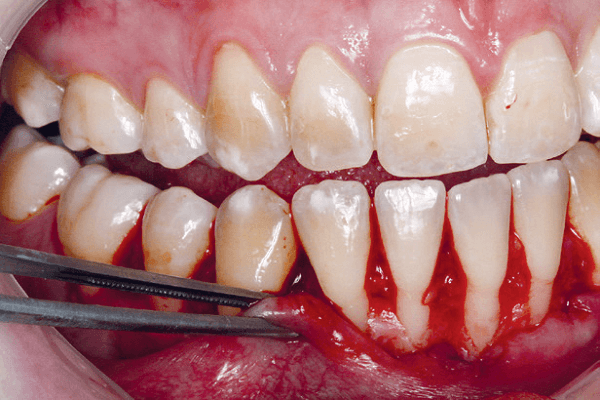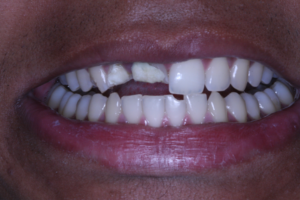RESUMO
A migração apical da margem gengival com exposição da superfície radicular é denominada recessão gengival, possui alta prevalência na população e aumenta em quantidade e severidade com o passar dos anos. O tratamento desta alteração pode ser necessário, já que o paciente pode apresentar lesões cervicais cariosas ou não cariosas, hipersensibilidade dentinária cervical, controle inadequado de biofilme, perda de inserção periodontal progressiva e queixas estéticas. Existem diversas possibilidades de técnicas cirúrgicas para o tratamento da recessão gengival, e a combinação que mostra resultados mais favoráveis é a realização de um retalho posicionado coronalmente e um enxerto de tecido conjuntivo subepitelial. O objetivo deste artigo foi realizar uma revisão da literatura e apresentar um caso clínico acerca da etiologia, prognóstico e tratamento cirúrgico da recessão gengival.
Palavras-chave – Recessão gengival; Tratamento cirúrgico; Enxerto gengival.
ABSTRACT
Gingival recession is defined by the apical migration of the gingival margin exposing the root surface. This alteration presents a high prevalence in the population and increases in number and severity along the years. The treatment of this condition may be necessary since the patient may present carious or non-carious cervical lesions, cervical dentinal hypersensitivity, inadequate plaque control, progressive periodontal attachment loss and aesthetic complaints. There are several surgical techniques to treat gingival recessions and the procedure that shows more favorable results is the combination of a coronally positioned flap and a subepithelial connective tissue graft. The aim of this article is to review the literature and present a clinical case about the etiology, prognosis, and surgical treatment of gingival recession.
Key words – Gingival recession; Surgical treatment; Gingival graft.
Referências
- Frizzera F, Molon RS, Kabach W, Verzola MHA, Orrico SRP, Sampaio JEC. Tratamento de recessões gengivais múltiplas: uma abordagem cirúrgica mais conservadora. PerioNews 2012; 6(1):18-28.
- Joly J, Carvalho PFM, da Silva RC. Alternativas cirúrgicas para o tratamento das recessões gengivais. In: Fonseca AS, Ranali J, Scopin O. Odontologia clínica para o exercício profissional diferenciado. Nova Odessa: Napoleão, 2010. p.73-102.
- Frizzera F, Fontanari LA, Tonetto MR, Kabbach W, Ottoni J, Masioli MA et al. Escultura gengival: abordagem cirúrgica em alterações gengivais estéticas. Clínica International Journal of Brazilian Dentistry 2012;8(4):388-400.
- Rajapakse PS, McCracken GI, Gwynnett E, Steen ND, Guentsch A, Heasman PA. Does tooth brushing influence the development and progression of non-inflammatory gingival recession? A systematic review. J Clin Periodontol 2007;34(12):1046-61.
- Danesh-Meyer MJ, Wikesjö UM. Gingival recession defects and guided tissue regeneration: a review. J Periodontal Res 2001;36(6):341-54.
- Roccuzzo M, Bunino M, Needleman I, Sanz M. Periodontal plastic surgery for treatment of localized gingival recessions: a systematic review. J Clin Periodontol 2002;29(suppl.3):178-94.
- Miller Jr. PD. A classification of marginal tissue recession. Int J Periodontics Restorative Dent 1985;5(2):8-13.
- Agustin Zeron J. Glossary of periodontal terms. Rev ADM 1990;47(6):350-8.
- Smith RG. Gingival recession. Reappraisal of an enigmatic condition and a new index for monitoring. J Clin Periodontol 1997;24(3):201-5.
- Loe H, Anerud A, Boysen H. The natural history of periodontal disease in man: prevalence, severity, and extent of gingival recession. J Periodontol 1992;63(6):489-95.
- Serino G, Wennström JL, Lindhe J, Eneroth L. The prevalence and distribution of gingival recession in subjects with a high standard of oral hygiene. J Clin Periodontol 1994;21(1):57-63.
- Baker DL, Seymour GJ. The possible pathogenesis of gingival recession. A histological study of induced recession in the rat. J Clin Periodontol 1976;3(4):208-19.
- Lindhe J, Karring T, Lang NP. Clinical periodontology and implant dentistry (4a ed) Oxford: Blackwell, 2003. p.1044.
- Newman GV, Goldman MJ, Newman RA. Mucogingival orthodontic and periodontal problems. Am J Orthod Dentofacial Orthop 1994;105(4):321-7.
- Stoner JE, Mazdyasna S. Gingival recession in the lower incisor region of 15-year-old subjects. J Periodontol 1980;51(2):74-6.
- Harrel SK, Nunn ME. The effect of occlusal discrepancies on gingival width. J Periodontol 2004;75(1):98-105.
- Bowers GM. A study of width of attached gingiva. J Periodontol 1963;34(3):201-9.
- Pini-Prato G, Cairo F, Nieri M, Franceschi D, Rotundo R, Cortellini P. Coronally advanced flap versus connective tissue graft in the treatment of multiple gingival recessions: a split-mouth study with a 5-year follow-up. J Clin Periodontol 2010;37(7):644-50.
- Mazzocco F, Comuzzi L, Stefani R, Milan Y, Favero G, Stellini E. Coronally advanced flap combined with a subepithelial connective tissue graft using full- or partial-thickness flap reflection. J Periodontol 2011;82(11):1524-9.
- Baldi C, Pini-Prato G, Pagliaro U, Nieri M, Saletta D, Muzzi L et al. Coronally advanced flap procedure for root coverage. Is flap thickness a relevant predictor to achieve root coverage? A 19-case series. J Periodontol 1999;70(9):1077-84.
- Hwang D, Wang HL. Flap thickness as a predictor of root coverage: a systematic review. J Periodontol 2006;77(10):1625-34.
- Edel A. Clinical evaluation of free connective tissue grafts used to increase the width of keratinised gingiva. J Clin Periodontol 1974;1(4):185-96.
- Prato GP, Pagliaro U, Baldi C, Nieri M, Saletta D, Cairo F et al. Coronally advanced flap procedure for root coverage. Flap with tension versus flap without tension: a randomized controlled clinical study. J Periodontol 2000;71(2):188-201.
- Aroca S, Keglevich T, Nikolidakis D, Gera I, Nagy K, Azzi R et al. Treatment of class III multiple gingival recessions: a randomized-clinical trial. J Clin Periodontol 2010;37(1):88-97.
- Hofmanner P, Alessandri R, Laugisch O, Aroca S, Salvi GE, Stavropoulos A et al. Predictability of surgical techniques used for coverage of multiple adjacent gingival recessions – a systematic review. Quintessence Int 2012;43(7):545-54.
- Bouchard P, Malet J, Borghetti A. Decision-making in aesthetics: root coverage revisited. Periodontol 2000 2001;27:97-120.
- Marini MG, Greghi SLA, Passanezi E, Sant’Ana ACP. Gingival recession: prevalence, extension and severity in adults. J Appl Oral Sci 2004;12(3):250-5.
- Martins AG, Andia DC, Sallum AW, Sallum EA, Casati MZ, Nociti Júnior FH. Smoking may affect root coverage outcome: a prospective clinical study in humans. J Periodontol 2004;75(4):586-91.
- Silva CO, de Lima AF, Sallum AW, Tatakis DN. Coronally positioned flap for root coverage in smokers and non-smokers: stability of outcomes between 6 months and 2 years. J Periodontol 2007;78(9):1702-7.
- Sato N. Periodontal surgery: a clinical atlas. Chicago: Quintessence Pub. Co., 2000. p.447.





